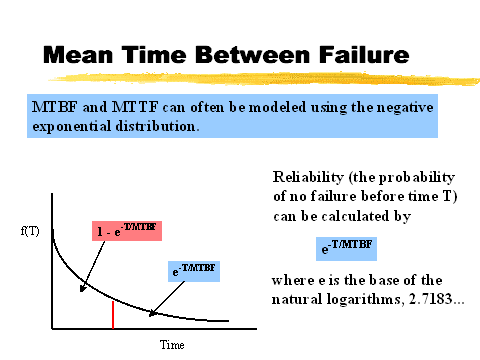Mean time between failures (MTBF) is the predicted elapsed time between inherent failures of a system during operation. MTBF can be calculated as the arithmetic mean (average) time between failures of a system. The MTBF is typically part of a model that assumes the failed system is immediately repaired (mean time to repair, or MTTR), as a part of a renewal process. This is in contrast to the mean time to failure (MTTF), which measures average time to failures with the modeling assumption that the failed system is not repaired (infinite repair time).
The definition of MTBF depends on the definition of what is considered a system failure. For complex, repairable systems, failures are considered to be those out of design conditions which place the system out of service and into a state for repair. Failures which occur that can be left or maintained in an unrepaired condition, and do not place the system out of service, are not considered failures under this definition. In addition, units that are taken down for routine scheduled maintenance or inventory control are not considered within the definition of failure.
The Overview
Mean time between failures (MTBF) describes the expected time between two failures for a repairable system, while mean time to failure (MTTF) denotes the expected time to failure for a non-repairable system. For example, three identical systems starting to function properly at time 0 are working until all of them fail. The first system failed at 100 hours, the second failed at 120 hours and the third failed at 130 hours. The MTBF of the system is the average of the three failure times, which is 116.667 hours. If the systems are non-repairable, then their MTTF would be 116.667 hours.
In general, MTBF is the "up-time" between two failure states of a repairable system during operation as outlined here:For each observation, the "down time" is the instantaneous time it went down, which is after (i.e. greater than) the moment it went up, the "up time". The difference ("down time" minus "up time") is the amount of time it was operating between these two events.
Once the MTBF of a system is known, the probability that any one particular system will be operational at time equal to the MTBF can be calculated. This calculation requires that the system is working within its "useful life period", which is characterized by a relatively constant failure rate (the middle part of the "bathtub curve") when only random failures are occurring. Under this assumption, any one particular system will survive to its calculated MTBF with a probability of 36.8% (i.e., it will fail before with a probability of 63.2%). The same applies to the MTTF of a system working within this time period.
MTBF value prediction is an important element in the development of products. However, it is incorrect to extrapolate MTBF to give an estimate of the life time of a component, which will typically be much less than suggested by the original MTBF due to the much higher failure rates in the "end-of-life wearout" part of the "bathtub curve".
Reliability engineers and design engineers often use reliability software to calculate a product's MTBF according to various methods and standards (MIL-HDBK-217F, Telcordia SR332, Siemens Norm, FIDES,UTE 80-810 (RDF2000), etc.). However, these "prediction" methods are not intended to reflect fielded MTBF as is commonly believed; the intent of these tools is to focus design efforts on the weak links in the design.
Formal definition of MTBF
By referring to the figure above, the MTBF is the sum of the operational periods divided by the number of observed failures. If the "Down time" (with space) refers to the start of "downtime" (without space) and "up time" (with space) refers to the start of "uptime" (without space), the formula will be:
The MTBF is often denoted by the Greek letter ?, or
The MTBF can be defined in terms of the expected value of the density function ƒ(t)
where ƒ is the density function of time until failure – satisfying the standard requirement of density functions –
In this context (of reliability) is density function ƒ(t) also often referred as reliability function R(t).
Variations of MTBF
There are many variations of MTBF, such as mean time between system aborts (MTBSA) or mean time between critical failures (MTBCF) or mean time between unscheduled removal (MTBUR). Such nomenclature is used when it is desirable to differentiate among types of failures, such as critical and non-critical failures. For example, in an automobile, the failure of the FM radio does not prevent the primary operation of the vehicle. Mean time to failure (MTTF) is sometimes used instead of MTBF in cases where a system is replaced after a failure, since MTBF denotes time between failures in a system which is repaired. MTTFd is an extension of MTTF, where MTTFd is only concerned about failures which would result in a dangerous condition.
MTTF and MTTFd calculation
where B10 is the number of operations that a device will operate prior to 10% of a sample of those devices would fail and nop are number of operations. B10d is the same calculation, but where 10% of the sample would fail to danger. nop is the number of operations/cycles.
Notes
- Jones, James V., Integrated Logistics Support Handbook, page 4.2
- Colombo, A.G., and Sáiz de Bustamante, Amalio: Systems reliability assessment – Proceedings of the Ispra Course held at the Escuela Tecnica Superior de Ingenieros Navales, Madrid, Spain, September 19–23, 1988 in collaboration with Universidad Politecnica de Madrid, 1988
- "Reliability and MTBF Overview" (PDF). Vicor Reliability Engineering. Retrieved 1 November 2014. "B10d Assessment - Reliability Parameter for Electro-Mechanical Components" (PDF). TUVRheinland. Retrieved 7 July 2015.

